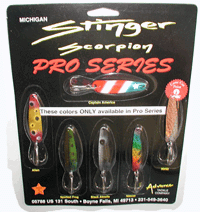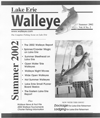|

Scorpion Stinger Spoons

Lake Erie Fishing
Maps

The Official Walleye.com
Lake Erie Walleye
Fishing Hat
|
Trolling Open-Water Walleye
Two Lake Erie Central Basin Charter Captains
Share Their Tips
By W. H. (Chip) Gross
One of a charter boat captainís toughest jobs is locating fish day after
day, week after week, month after month. And once heís found fish, he must
be able to put them in the boat for his clients. Two
 of
the best at doing that in Lake Erieís vast Central Basin are charter
captains Jim Cooper and Bob Schmidt. Both captains run boats out of Lorain,
Ohio and are members of the Central Basin Charter Boat Association.
Following are a few of their suggestions for catching walleyes and steelhead
by trolling. of
the best at doing that in Lake Erieís vast Central Basin are charter
captains Jim Cooper and Bob Schmidt. Both captains run boats out of Lorain,
Ohio and are members of the Central Basin Charter Boat Association.
Following are a few of their suggestions for catching walleyes and steelhead
by trolling.
Captain Jim Cooper on:
A Basic Trolling Spread
"Ohio fishing law allows two rods per licensed angler, so if I have six
customers, a mate, and myself onboard I run 16 lines at once. My spread
normally consists of eight directional diver rods (4 on each side of the
boat) and six planer board rods (3 on each side). In addition, I and some of
the other boats in the area also run downriggers. Of the three methods, the
downriggers seem to catch fewer walleyes than the other two. However, when
the steelhead are running the Ďriggers work great. I recommend using the
same make and length of rod for the board lines. I also run them straight up
in the air. That way, itís easy to tell if you have a small fish hanging on
when you see one rod bent more than the others. For my directional-diver
rods, I run 7-, 8-, 9-, and 10-footers. This gives me a little more
separation between rods. I lay them down in a horizontal position in the rod
holders."
Preferred Lines
"I run 50-pound test braid that has 12-pound diameter. This line,
combined with 25-pound test fluorocarbon leaders, has really cut down on
lost fish because of line breakage. I recommend fluorocarbon leaders because
they are close to being invisible, are soft yet tough, have minimal memory,
are abrasion
 resistant,
and have minimum stretch. I cut my leaders in six foot lengths. Many people
use rubber snubbers between a diver and the leader. I personally havenít had
any problems landing walleyes without them, but I do run snubbers on the
divers closest to the boat when steelhead are in the area. Good snap swivels
are also important." resistant,
and have minimum stretch. I cut my leaders in six foot lengths. Many people
use rubber snubbers between a diver and the leader. I personally havenít had
any problems landing walleyes without them, but I do run snubbers on the
divers closest to the boat when steelhead are in the area. Good snap swivels
are also important."
Preferred Baits
"In the Lorain area, spoons are very popular, whereas east of Cleveland
worm harnesses seem to be used more. I run mainly spoons, worm harnesses,
and shallow diving plugs. When running deep-diving plugs, I donít run them
off diving devices as they will pull the back of the diver down causing it
to come to the surface. Controlling lure depth is extremely important. Iíve
always said that Iíd rather be running the wrong lure at the right depth
than the right lure at the wrong depth. Itís also better to be running baits
a little above fish than below. If youíre not catching fish, donít be afraid
to experiment with various depths and baits."
Captain Bob Schmidt on:
Finding Fish
"Zebra mussels continue to have a drastic effect on the water clarity of
the lake, and as a result I recently bought a speed and temperature gauge to
help me find the comfort zone of fish. I thought that would help me locate
the fish themselves, but what I discovered was this. In the mornings, as the
sun was just coming up, light penetration was only about ten percent at 45
feet. But very quickly the light increased to 100 percent by about nine a.m. and stayed that way all day until evening. I checked it
many days and at all depths and got similar readings. The only difference
was after a storm when the water was turbid.
by about nine a.m. and stayed that way all day until evening. I checked it
many days and at all depths and got similar readings. The only difference
was after a storm when the water was turbid.
"I was having trouble catching fish at the normal [pre-zebra mussel]
water levels. It didnít make any difference what baits I used, the results
were the sameósome fish, but not the numbers I needed. What I believed was
happening was this. If the light-shy walleyes wanted to feed during the day,
they had to do it in bright light no mater what the depth. So I started
looking for bait fish and usually found them up around ten feet. I tried
running baits off #10 Jet Divers from a planer board on one side of the boat
and #20s on the other side. That did the trick; I started catching more
fish. I was even able to run flat lines at times. The point is this, with
that much light in the water it didnít make any difference where the fish
were in the water column, they couldnít get away from the sunlight. And if
they wanted to eat they eventually had to come to where the bait was,
oftentimes very high. I was limiting out by running most of my baits high
when other captains were struggling to get just a few fish."
Braided Line vs. Mono
"Iíve tried some of the new braided fishing lines on my trolling reels
(30-pound test, 8-pound diameter) and found that itís so thin itís like
using sewing thread. Knots are almost impossible to untangle. It gets Dipsy
Divers down fast and deep, but too deep and too close to the boat, in my
opinion. Monofilament for running Dipsyís has its disadvantages too because
of line stretch, but given a choice, and with water fleas now in the lake
accumulating on trolling lines, the new oval-shaped monofilaments might be
the way to go."
Spoons
"Lake Erie walleyes and steelhead love Michigan Stinger spoons, but as
most trollers know the paint on the older spoons peels off easily. I repaint
my old spoons with powdered paint that you melt onto the spoons. If you have
the time and the will to do it they work great, and the paint stays on. You
can also add some metallic tape to the spoon to give it more flash. I like
pink best, but most colors worked for me last year. I usually had at least
two or three spoons in the water at all times."
For more information contact:
Central Basin Charter Boat Association Ė 1-800-686-4702 or
www.cbcba.com
Captain Bob Schmidt Ė BoKay Fishing Charters, 888-551-0440
Captain Jim Cooper Ė J & H Fishing Charters, 800-595-6673
|





 of
the best at doing that in Lake Erieís vast Central Basin are charter
captains Jim Cooper and Bob Schmidt. Both captains run boats out of Lorain,
Ohio and are members of the Central Basin Charter Boat Association.
Following are a few of their suggestions for catching walleyes and steelhead
by trolling.
of
the best at doing that in Lake Erieís vast Central Basin are charter
captains Jim Cooper and Bob Schmidt. Both captains run boats out of Lorain,
Ohio and are members of the Central Basin Charter Boat Association.
Following are a few of their suggestions for catching walleyes and steelhead
by trolling.  resistant,
and have minimum stretch. I cut my leaders in six foot lengths. Many people
use rubber snubbers between a diver and the leader. I personally havenít had
any problems landing walleyes without them, but I do run snubbers on the
divers closest to the boat when steelhead are in the area. Good snap swivels
are also important."
resistant,
and have minimum stretch. I cut my leaders in six foot lengths. Many people
use rubber snubbers between a diver and the leader. I personally havenít had
any problems landing walleyes without them, but I do run snubbers on the
divers closest to the boat when steelhead are in the area. Good snap swivels
are also important."  by about nine a.m. and stayed that way all day until evening. I checked it
many days and at all depths and got similar readings. The only difference
was after a storm when the water was turbid.
by about nine a.m. and stayed that way all day until evening. I checked it
many days and at all depths and got similar readings. The only difference
was after a storm when the water was turbid.